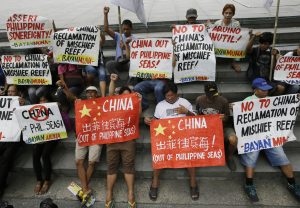Amid the focus on China’s alleged pandemic opportunism, it’s worth keeping the sober bigger picture in perspective in the South China Sea: that China remains focused on creating a new normal where it has the ability to enforce what it sees as its legitimate claims, and that the response to Beijing’s quest has thus far not been sufficient to blunt it. While reversing this reality will require adjustments on multiple fronts, it cannot occur unless familiar gaps are bridged in responses by claimant states and interested parties in Southeast Asia.
Over the past decade, though the focus of the headlines may shift based on individual developments – be it China’s documented artificial-island building campaign or the reversal of the Philippines’ South China Sea approach with the election of Rodrigo Duterte – the reality is that China has pursued a steady course aimed at securing de facto control of the South China Sea, and the response from other interested parties has been inadequate. This is not because the flood of commentaries prescribing what should be done have fallen on deaf ears, but rather due to a series of rather familiar obstacles to translating these ideas into reality – including the massive asymmetry of capabilities between China and other claimant states and Beijing’s far greater commitment to realizing its objectives in the South China Sea than other powers’ — including Washington’s — will to obstruct it from doing so.
While China may not have won yet in the South China Sea, time is running out to fashion a stronger collective response to blunt Beijing’s new normal quest. The massive imbalance of power in the South China Sea has been repeatedly demonstrated in increasingly bold instances of Chinese coercion, which are met with varying degrees of seriousness by Southeast Asian states depending on the individual circumstance. Negotiations – both multilaterally through the seemingly neverending ASEAN-China Code of Conduct talks and bilaterally between China and the Philippines – have unsurprisingly seen few breakthroughs. And while outside actors such as the United States and Japan have been more active in the South China Sea, more fundamental issues with respect to U.S. policy remain unresolved and few would argue that this has changed the overall picture of China’s incremental gains.
Though reversing this reality will require a lot more across a range of fronts, it cannot be done without – and must necessarily start with – the claimant states and interested parties in Southeast Asia. A claimant-led approach ensures that the countries most invested in an outcome are leading the process and are backed by sufficient and sustainable political will generated from their governments as well as broader societies. And this also provides a clear and strong “floor” to build out from and can reinforce other lines of effort, be it diplomacy through ASEAN, which is vulnerable to division, or alignment with major powers such as the United States, who can then do more while also effectively rebutting the Chinese line that the South China Sea issue is something that is being artificially engineered by outside troublemakers.
What exactly a claimant-led approach involves has actually long been clear. Part of it is about what parties can do individually. This starts with the basics, including individual countries being clear and consistent both publicly and privately when they are confronted with Chinese coercion in the South China Sea rather than expecting others to speak up on their behalf. As I have pointed out previously in response to a China-Malaysia incident, it has become increasingly apparent that doing so can help better distribute the burden of blunting China’s efforts, make clear to Beijing that it faces resistance on multiple fronts, and also help claimants reinforce their own national responses as well, which should involve not only governments but societies more broadly.
But beyond this, blunting China’s new normal quest will require a lot more collective action. Beyond familiar efforts such as joint patrols, which Philippine Supreme Court Justice Antonio Carpio recently reiterated, more interclaimant cooperation can also be realized in nonmilitary realms as well, including in the legal realm. More discussion and research can also help, with cases in point being the discussions organized at CSIS Indonesia between Malaysia, Vietnam, and Indonesia and ongoing polling conducted by the Institute of Southeast Asian Studies in Singapore, which is increasingly being expanded to include questions on more granular issues across the region.
To be sure, all this will need to be paired by other lines of effort as well, be it the calibration of other elements of these claimant states’ increasingly growing and complex ties with China as well as collaboration with like-minded external partners within Asia as well as beyond it. And even with all of this, it is far from clear whether this will be sufficient to blunt China’s new normal quest. But while bridging claimant gaps is of course not where addressing Beijing’s South China Sea behavior ought to end, it is certainly one important place to start if the status quo is to change anytime soon in a meaningful way.

































